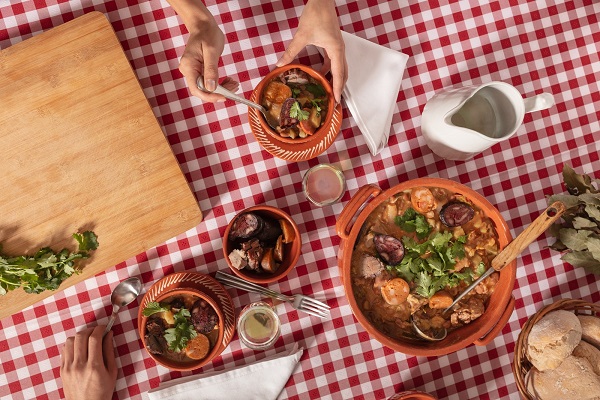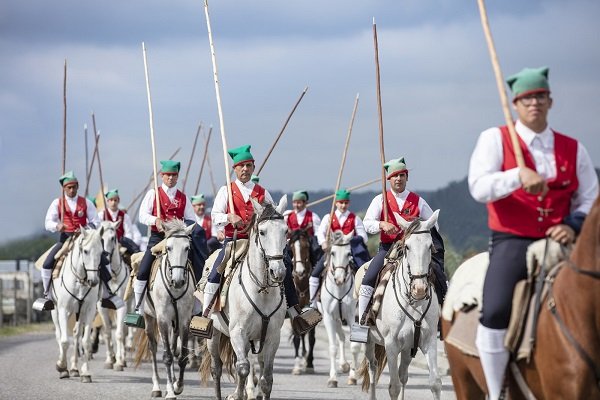The Ribatejo is the northwestern region of the Alentejo crossed by the Tejo River, just north of Lisbon. It is a treat to explore, from ancient cities, big events, to some of the best cuisine in all of Portugal. Officially created as a province in 1936, Ribatejo is farm country with rich agricultural lands in the valley of the Tejo River. This is also horse country — with numerous horse farms and fairs. Covering more than 400 square miles, Ribatejo means ‘banks of the Tejo’ — and is Portugal’s agricultural heartland.
Cuisine
Cuisine
The fertile Ribatejo grows a variety of crops: Grapes, corn, rice, wheat, tomato, sugar beets, melons and olives. The Ribatejo "Branco Melon” is a medium-sized melon that is sweet and fragrant when ripe. When they are in season, roadside stands abound in the region. Cuisine includes river eels that are served fried or stewed, açorda bread stews, and the famous stone soup.
In the Ribatejo not only are the rolling landscapes scenic, but one can explore the Reserva Natural do Estuário do Tejo, or Tagus Estuary Nature Reserve. This wetland is a stop for migrating bird species on the way between Africa and Northern Europe.


Wines
Some of Portugal’s best table wines, particularly whites, are produced in the Ribatejo. Naturally irrigated by the Tejo, the many grapes planted in the floodplain produce a wonderful wine. In the Ribatejo, there are lots of local wines: Almeirim, Santarém, Chamusca and Coruche are all producers of local wines. One of the most celebrated is from the Cartaxo Region. The Cartaxo Wine Cooperative has won 176 national and international awards. The Cartaxo Festa do Vinho is an annual event held in Cartaxo.
Horses and Riding
On the lezírias (from the Arabic al-jazira or "the island") the fertile banks of the River Tejo, horses run, and crops grow. This is the home of the beautiful horses called the Lusitano. Native to Portugal, the Lusitano breed is famed for its character and courage in both the bullring and in war. Majestic and smart, the Lusitano has made a name of itself in dressage, too.
On the banks of the river, fine horses and cattle graze all over the region, The Ribatejo lezírias are home to the campino, who are easy to spot in traditional dress, with a green and red long cap with tassel, white shirt, red vest, riding trousers and white stockings. They ride the lezírias.
The Golegã horse fair is held every November - and a great place to admire the magnificent Lusitano and Alter breeds.
The Companhia das Lezírias (Lezírias Company) is a state-run agriculture and forestry company in the pretty town Benavente, started by the Portuguese Crown in the 19th century. Today, the company produces rice, wine, cork, and livestock, as well as being a respected horse breeder and organizer of big equestrian events.
Sites
Santarém is a short rial trip north of Lisbon, and above the Tejo. The city, still in its walls in places, is called the Portuguese Gothic-Capital for its abundance of Gothic architecture. It is a city of green squares, parks, and vistas.
Santarém is a city of both great food and monuments. Since 1981 the National Culinary Festival has been held here. Each fall, Santarém hosts some of the best restaurants in Portugal, where you can try traditional specialties of each region.
Golegã is the capital of horse country. Since the eighteenth century, the Feira da Golegã, also called the Feira de S. Martinho, has been Portugal’s National Horse Fair. Here the finest purebreds are shown. And to complement the event, there is a lot of great food, wine and roasted chestnuts.
Chamusca is a quaint farming town on the Tejo River. The river can be viewed from the Senhora do Pranto and Senhor do Bonfim scenic overlooks.
Almeirim sits in the midst of vineyards and cork forests. The "capital of stone soup," the recipe dates back generations, and the soup is the reason many come to this charming town.
Bustling Coruche is set on the River Sorraia, surrounded by rice fields, and home to a lively riverfront with great eateries. Coruche is one of the biggest cork producers in Portugal. Walk the Corôa bridge and check out several 17th century churches.
At Alpiarça, check out the Casa dos Patudos, a museum house built by José Relvas (1858-1929), a diplomat who helped to proclaim the Portuguese Republic in 1910.



